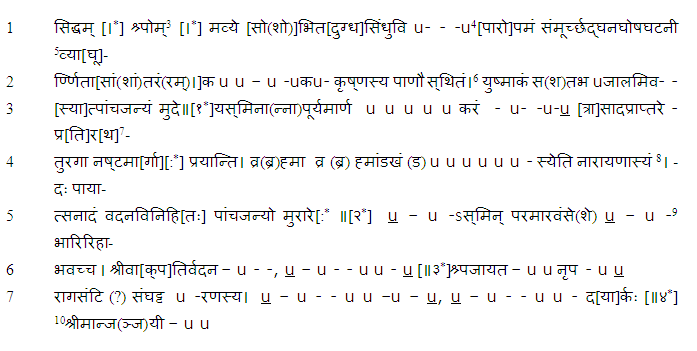|
The Indian Analyst
|
North Indian Inscriptions |
INSCRIPTIONS OF THE PARAMARAS OF MALWA ...As already stated above, the inscription is mutilated ; and the idea of its contents as may be formed from what is legible is as follows. It opens with two symbols followed by two stanzas which invoke the blessings of Pāñchajanya, the conch of Murāri, and of Nārāyaṇa as the deity is called respectively in the first and the second of the verses. The following four verses are devoted to describe the Paramāra family and three of the rulers belonging to it viz., Vākpati, Sīyaka and Udayāditya. The description is wholly conventional. It is not known if some other names, with that of Bhōjadēva, who was the most illustrious ruler belonging to that family, are lost in the missing portion. However, as all the rulers mentioned here are known from the other records of the house, the present inscription does not add to our know. ledge so far as the genealogy of the house is concerned. ...The next five verses (5-9) describe the ancestors of Vikrama who caused the tank to be excavated. The first personage introduced here is Stambha of the Bhāradhvāja gōtra. His son’s name is partly lost in the next verse, but the first three aksharas thereof appear to be Ahalla ; the latter’s son was Vikrama, who was endowed with great fame. He got the tank constructed and the amount spent, mentioned both in words and figures, was 2.500 coins stamped with royal effigy. [1] ...Verses 10-15 describe the tank, stating that it had wide banks and it was a resort of acquatic animals like fishes, crocodiles and others, It was built with stainless (dressed) stone and for the use of bathing, offering prayers, worshipping gods and sages and presenting libations to the manes of deseased ancestors. It is also said that considering the great merit of making provision for water, it was built by Vikrama by spending the amount which he had earned by just means (śuddhair dhanair) and by the strength of his arms (sva-bhuj-ōpārjita). This undoubtly shows that he must have fought some battles under Naravarman, as a general, or a warrior, but the details are not known.
...This account is followed by the date and the names of the writer and the engraver, as seen above. And in the middle of the last line is engraved a name Māluḥ, which is a subsequent addition, as already seen. ...No Place-name is recorded in the inscription.
TEXT
[2]
[1] Ṭaṅkaka, the word used here, means ‘a stamped coin, especially of silver’.
|
||||||||||||||||||||||||||||||||||||||||||||||||||||||||||||||||||||||||||||||||||||||
| > |
|
>
|









